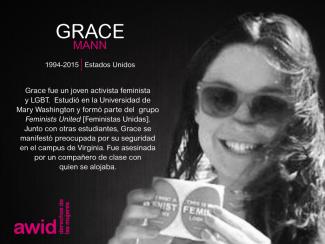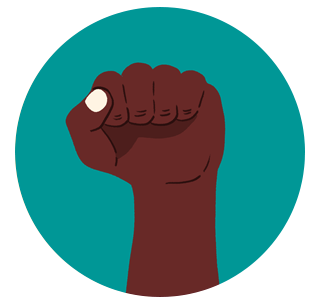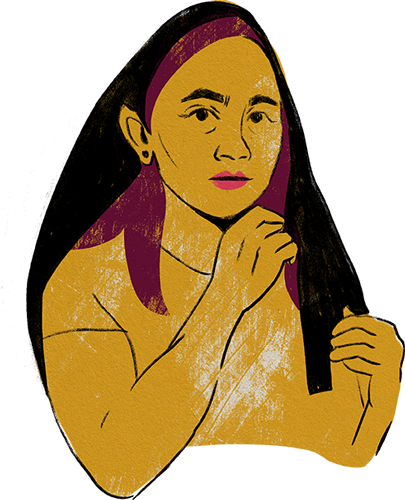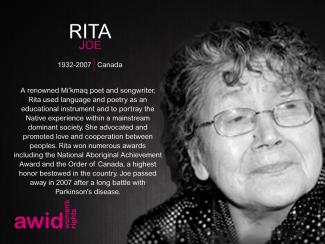
Grace Mann

In September 2016, the 13th AWID international Forum brought together in Brazil over 1800 feminists and women’s rights advocates in a spirit of resistance and resilience.
This section highlights the gains, learnings and resources that came out of our rich conversations. We invite you to explore, share and comment!
One of the key takeaways from the 2016 Forum was the need to broaden and deepen our cross-movement work to address rising fascisms, fundamentalisms, corporate greed and climate change.
With this in mind, we have been working with multiple allies to grow these seeds of resistance:
And through our next strategic plan and Forum process, we are committed to keep developing ideas and deepen the learnings ignited at the 2016 Forum.
AWID Forums started in 1983, in Washington DC. Since then, the event has grown to become many things to many peoples: an iterative process of sharpening our analyses, vision and actions; a watershed moment that reinvigorates participants’ feminisms and energizes their organizing; and a political home for women human rights defenders to find sanctuary and solidarity.
En este Foro, vamos a celebrar y multiplicar las propuestas poderosas que nos rodean, en sus distintos estadios de evolución.

1 |
Fornecer a membres da AWID, parceires do movimento e financiadores uma análise atualizada, robusta, baseada em fatos e orientada para a ação das realidades do financiamento de movimentos feministas e do estado atual do ecossistema do financiamento feminista. |
2 |
Identificar e demonstrar oportunidades para transferir mais recursos de maior qualidade para a organização feminista, expor soluções falsas e interromper tendências que fazem com que o financiamento não seja bem-sucedido e/ou se mova contra a justiça de género e objetivos feministas interseccionais. |
3 |
Articular visões, propostas e objetivos feministas para a justiça no financiamento. |
Una nómada de las culturas, nacida en Hong Kong y con raíces turco-paquistaníes, el amor de Fatima por la narración, ya sea su lectura o su creación conjunta, le infundió la pasión por el activismo de las comunicaciones. Formada en periodismo, ha trabajado durante siete años en los ámbitos de la comunicación digital y los medios de comunicación con ONG que brindan oportunidades educativas y asistencia jurídica a personas refugiadas y solicitantes de asilo, así como con el movimiento feminista musulmán, que aplica un enfoque feminista y de derechos para comprender y buscar la igualdad y la justicia en la tradición jurídica musulmana. Escribe con habitualidad artículos de opinión sobre asuntos feministas en el Sur Global.
Mediante la narración en esta era hiperdigital de las redes sociales, Fatima sigue colaborando con organizadores comunitaries y activistas de base para crear contenido audiovisual, a fin de tender puentes de comprensión hacia la liberación colectiva y la descolonización. Durante los días en que no trabaja, mira atentamente largometrajes feministas independientes de Irán, Marruecos y Pakistán, e interpreta poesía oral con sus camaradas de Kuala Lumpur.
Laurie Carlos was an actor, director, dancer, playwright, and poet in the United States. An extraordinary artist and visionary with powerful ways of bringing the art out in others.
“Laurie walked in the room (any room/every room) with swirling clairvoyance, artistic genius, embodied rigor, fierce realness—and a determination to be free...and to free others. A Magic Maker. A Seer. A Shape Shifter. Laurie told me once that she went inside people’s bodies to find what they needed.” - Sharon Bridgforth
She combined performance styles such as rhythmic gestures and text. Laurie mentored new actors, performers, writers and helped amplify their work through Naked Stages, a fellowship for emerging artists. She was an artistic fellow at Penumbra Theater and supported with identifying scripts to produce, with a goal of “bringing more feminine voices into the theater”. Laurie was also a member of Urban Bush Women, a renowned contemporary dance company telling stories of women of the African diaspora.
In 1976, as Lady in Blue, she made her Broadway debut in Ntozake Shange’s original and award-winning production of the poetic drama For colored girls who have considered suicide / when the rainbow is enuf. Laurie’s own works include White Chocolate, The Cooking Show, and Organdy Falsetto.
“I tell the stories in the movement—the inside dances that occur spontaneously, as in life—the music and the text. If I write a line, it doesn’t necessarily have to be a line that is spoken; it can be a line that’s moved. A line from which music is created. The gesture becomes the sentence. So much of who we are as women, as people, has to do with how we gesture to one another all the time, and particularly through emotional moments. Gesture becomes a sentence or a state of fact. If I put on a script ‘four gestures,’ that doesn’t mean I’m not saying anything; that means I have opened it up for something to be said physically.” Laurie Carlos
Laurie was born and grew up in New York City, worked and lived in Twin Cities. She passed away on 29 December 2016, at the age of 67, after a battle with colon cancer.
“I believe that that was exactly Laurie’s intention. To save us. From mediocrity. From ego. From laziness. From half-realized art making. From being paralyzed by fear.
Laurie wanted to help us Shine fully.
In our artistry.
In our Lives.” - Sharon Bridgforth for Pillsbury House Theatre
“There’s no one that knew Laurie that wouldn’t call her a singular individual. She was her own person. She was her own person, her own artist; she put the world as she knew it on stage with real style and understanding, and she lived her art.” - Lou Bellamy, Founder of Penumbra Theater Company, for Star Tribune



 |
Tshegofatso Senne es unx feminista queer negrx con una enfermedad crónica. Buena parte parte de su trabajo se inscribe en el placer, la comunidad y los sueños, para el que se nutre del abolicionismo somático y la discapacidad, la sanación y las justicias transformadoras. Escribiendo, investigando y expresándose sobre cuestiones concernientes al feminismo, la comunidad, la justicia sexual y reproductiva, el consentimiento, la cultura de la violación y la justicia, Tshegofatso ha adquirido ocho años de experiencia teorizando sobre la intersección de estos tópicos con el placer. Tiene su propia actividad comercial, Thembekile Stationery, y la plataforma comunitaria Hedone, un espacio de reunión para analizar y comprender el poder de la toma de conciencia del trauma y el placer en la vida cotidiana. Tshegofatso trabaja con jóvenes de todo el continente, organiza talleres, presta asesoramiento en cuestiones de placer y liberación, y usa la creatividad y la narración como soluciones fractales a las injusticias sociales. |

En el cuerpo, no en el cerebro pensante, es donde experimentamos la mayoría de nuestro dolor, placer y alegría y donde procesamos la mayoría de lo que nos pasa. Es también donde realizamos la mayor parte de nuestra sanación, incluyendo nuestra sanación emocional y psicológica. Y es donde experimentamos la resiliencia y una sensación de fluidez.
Estas palabras, escritas por Resmaa Menakem en su libro My Grandmother’s Hands [Las manos de mi abuela], se han quedado conmigo.
El cuerpo alberga nuestras experiencias. Nuestras memorias. Nuestra resiliencia. Y como ha escrito Menakem, el cuerpo también alberga nuestros traumas. Responde con mecanismos de protección espontáneos para detener o evitar más daños. El poder del cuerpo. El trauma no es el evento mismo; es cómo responden nuestros cuerpos a los eventos que sentimos como peligrosos. A menudo queda atravesado en el cuerpo, hasta que lo abordamos. No se puede convencer a nuestro cuerpo de que no responda, simplemente lo hace.
Utilizando Digital Superpower, la aplicación de Ling Tan, fui registrando cómo se sentía mi cuerpo mientras recorría diferentes partes de mi ciudad, Johannesburgo, Sudáfrica. La aplicación es una plataforma guiada por gestos que te permite registrar tus percepciones mientras te mueves a través de diferentes lugares, cargando y grabando los datos. Yo la usé para registrar mis síntomas psicosomáticos (reacciones físicas conectadas a una causa mental). Podían ser flashbacks. Ataques de pánico. Opresión en el pecho. Un ritmo cardíaco rápido. Dolores de cabeza tensionales. Dolor muscular. Insomnio. Dificultad para respirar. Registré estos síntomas mientras caminaba y recorría distintas partes de Johannesburgo. Y me pregunté.
¿Dónde podemos estar segurxs? ¿Podemos estar segurxs?
Las respuestas psicosomáticas pueden ser causadas por una cantidad de cosas, y algunas no son tan severas como otras. Después de vivir cualquier tipo de trauma, puedes sentir un intenso malestar en eventos o situaciones parecidas. Registré mis sensaciones, ordenadas en una escala del 1 al 5, en la que el 1 representaba las instancias en las que apenas sentí alguno de estos síntomas – me sentía más cómoda que en guardia o nerviosa, mi respiración y mi ritmo cardíaco eran estables, no estaba mirando sobre mi hombro – y el 5 era lo opuesto: los síntomas me tenían cerca del ataque de pánico.
Como persona negra. Como persona queer. Como persona de género queer que puede ser percibida como mujer, dependiendo de cuál sea mi expresión de género ese día.
Me pregunté.
¿Dónde podemos estar segurxs?
Incluso en barrios que se podrían considerar «seguros», me he sentido constantemente en pánico. Mirando alrededor mío para asegurarme de que no me estaban siguiendo, acomodándome la camiseta de manera que no se me noten tanto los pechos, mirando alrededor para asegurarme de encontrar numerosas rutas para salir del lugar en el que estaba si me sintiera en peligro. Un camino vacío provoca ansiedad. Uno atestado también lo hace. Estar en un Uber también. Caminar en un camino público también. Estar en mi departamento también. Y también lo hace recibir una entrega a domicilio en la puerta de entrada del edificio.
¿Podemos estar segurxs?
Pumla Dineo Gqola habla de la fábrica de miedo femenino. Puede o no resultarte familiar, pero si eres alguien socializadx como mujer, conocerás bien esta sensación. La sensación que te hace planificar cada paso que das, ya sea que vayas a trabajar, a la escuela, o simplemente a hacer algún trámite. La sensación de que tienes que fijarte cómo te vistes, cómo actúas, cómo hablas tanto en público como en privado. La sensación en la boca del estómago si tienes que viajar de noche, recibir una entrega a domicilio o tratar con cualquier persona que sigue socializado como hombre cis. Acosadx en la calle, siempre con la amenaza de la violencia. Nuestra existencia en cualquier espacio viene con un miedo innato.
El miedo es tanto un fenómeno individual como sociopolítico. A nivel individual, el miedo puede presentarse como parte de un sistema de alarma saludable y bien desarrollado [...] Cuando pensamos en el miedo, es importante sostener ideas tanto acerca de la experiencia emocional individual como de las maneras políticas en las cuales el miedo ha sido utilizado para el control en diferentes épocas.
- Pumla Dineo Gqola, en su libro Rape: A South African Nightmare [La violación, una pesadilla sudafricana]
Las mujeres, femmes y queers sudafricanxs sabemos que cada paso que damos afuera – pasos para hacer las cosas cotidianas: caminar a las tiendas, un taxi al trabajo, un Uber desde una fiesta – todos estos actos son una negociación con la violencia. Este miedo es parte del trauma. Para soportar el trauma que cargamos en nuestros cuerpos, desarrollamos respuestas para detectar el peligro: mirar las respuestas emocionales de aquellxs a nuestro alrededor, leer buscando la «simpatía». Estamos constantemente en guardia.
Día tras día. Año tras año. Vida tras vida. Generación tras generación.
Acerca del desafío adicional de este sistema de defensa aprendido, Bessel Van Der Kolk, autor de The Body Keeps Score [El cuerpo lleva la cuenta], dijo:
Es que perturba esta capacidad de leer a otrxs con precisión, dejando a lx sobreviviente de trauma menos capaz de detectar el peligro o más proclive a percibir erróneamente peligro donde no lo hay. Insume una tremenda cantidad de energía seguir funcionando mientras se carga con la memoria del terror y la vergüenza de la absoluta debilidad y vulnerabilidad.
Como ha dicho Resmaa Menakem, el trauma está en todo. Se infiltra en el aire que respiramos, el agua que tomamos, los alimentos que comemos. Está en el sistema que nos gobierna, en la institución que nos enseña y que también nos trauma y dentro de los contratos sociales que acordamos con lxs demás. Lo que es más importante, lo llevamos con nosotrxs a todos lados a donde vamos, en nuestros cuerpos, mientras nos agota y erosiona nuestra salud y felicidad. Llevamos esa verdad en nuestros cuerpos. Lo hemos hecho durante generaciones.
Así que, mientras camino por mi ciudad, ya sea en un área que es considerada «segura» o no, llevo los traumas de generaciones cuyas respuestas están integradas a mi cuerpo. Mi corazón palpita, se hace difícil respirar, mi pecho se tensa, porque mi cuerpo siente como si el trauma estuviera sucediendo en ese mismo momento. Vivo en hiper vigilancia. Hasta el punto en el que unx está demasiado en guardia como para poder disfrutar plenamente su vida, o demasiado adormecidx para absorber nuevas experiencias.
Para comenzar a sanar, debemos reconocer estas verdades.
Estas verdades que viven en nuestros cuerpos.
Este trauma es lo que nos impide a muchxs vivir las vidas que queremos. Pregunta a cualquier femme o persona queer cómo es para ellxs la seguridad y seguramente te darán ejemplos de tareas simples: ser capaz de simplemente vivir vidas alegres, sin la amenaza constante de la violencia.
Las sensaciones de seguridad, de comodidad y de facilidad, son espaciales. Cuando encarnamos nuestro trauma, afecta las formas en las que percibimos nuestra propia seguridad, afecta las maneras en las que interactuamos con el mundo y altera las maneras en las que somos capaces de experimentar y encarnar cualquier cosa placentera y alegre.
Tenemos que rehusarnos a esta pesada responsabilidad y luchar por un mundo seguro para todxs. Caminando heridxs, como estamos muchxs, somos luchadorxs. El patriarcado puede aterrorizarnos y brutalizarnos, pero no abandonaremos la lucha. Cada vez que salimos a la calle, desafiando el miedo de maneras espectaculares y aparentemente insignificantes, nos defendemos y hablamos en nuestro propio nombre.
- Pumla Dineo Gqola, en su libro Rape: A South African Nightmare [Violación, una pesadilla sudafricana]
¿Dónde podemos estar segurxs? ¿Cómo comenzamos a defendernos, no solo en el sentido físico, sino en sentido emocional, psicológico y espiritual?
«El trauma nos convierte a todxs en armas», dijo adrienne maree brown en una entrevista realizada por Justin Scott Campbell. Y su obra, Pleasure Activism [Activismo del placer], nos ofrece numerosas metodologías para sanar ese trauma y afianzarnos en la comprensión de que la sanación, la justicia y la liberación también pueden ser experiencias placenteras. Especialmente quienes estamos más marginadxs, quienes puede que hayamos sido criadxs para equiparar el sufrimiento con «El trabajo». El trabajo que nos hemos tomado tantxs como activistas, constructorxs de comunidades, aquellxs que atienden a lxs más marginadxs, El trabajo que luchamos por hacer, quemándonos y raramente cuidando nuestras mentes y cuerpos. La alternativa es hacernos más conscientes de nuestro trauma, capaces de identificar nuestras propias necesidades y encarnar eso profundamente. Ese encarnar significa simplemente que somos más capaces de experimentar el mundo a través de los sentidos y las sensaciones en nuestros cuerpos, reconociendo lo que nos dicen, en vez de suprimir e ignorar la información que nos están comunicando.
Estar en conversación constante con nuestro cuerpo vivo y sostener intencionalmente esas conversaciones nos conecta más profundamente con lo encarnado, nos permite hacer tangibles las emociones que sentimos cuando interactuamos con el mundo, amigarnos con nuestros cuerpos y entender todo lo que están tratando de enseñarnos. Cuando entendemos que el trauma y el encarnar están acoplados, podemos comenzar la sanación y acceder al placer más integralmente, saludablemente, y en nuestras vidas cotidianas sin vergüenza ni culpa. Podemos comenzar a acceder al placer como una herramienta para el cambio individual y social, aprovechando el poder de lo erótico, como lo describió Audre Lorde. Un poder que nos permite compartir la alegría a la que accedemos y que vivimos, ampliando nuestra capacidad para la felicidad y entendiendo que somos merecedorxs de ello, incluso con nuestro trauma.
Aprovechar el placer y la encarnación de lo erótico nos da la amplitud de estar deliberadamente vivxs, sintiéndonos afianzadxs y estables y entendiendo nuestros sistemas nerviosos. Nos permite entender y descargarnos del equipaje generacional que hemos estado acarreando sin darnos cuenta; podemos tener el poder que nos da el conocimiento de que incluso tan traumatizadxs como estamos, tan traumatizadxs como podríamos estar en el futuro, aún somos merecedorx de vidas placenteras y alegres, que podemos compartir ese poder con nuestra gente. Es el aspecto comunitario lo que está faltando en la forma en que nos cuidamos; el autocuidado no puede existir sin cuidado comunitario. Somos capaces de sentir una confianza, seguridad y poder internos más profundos en nosotrxs mismxs, especialmente de cara a traumas futuros que van a ser disparadores, sabiendo cómo tranquilizarnos y estabilizarnos. Todo este entendimiento nos lleva a un poder interior más profundo que tiene recursos para enfrentar cualquier desafío que surja en nuestro camino.
Como somos lxs que vivimos con profundos traumas generacionales, nos hemos vuelto desconfiadxs y quizás pensemos que somos incapaces de contener y acceder al poder que tenemos. En «Los usos de lo erótico: lo erótico como poder», Lorde nos enseña que lo erótico nos ofrece una fuente de recarga, una forma de exigir lo mejor para nosotrxs y para nuestras vidas.
Porque lo erótico no es solo se trata de lo que hacemos, es una cuestión de con cuánta intensidad y plenitud podemos sentirnos mientras lo hacemos. Una vez que sabemos en qué medida somos capaces de sentir esa sensación de satisfacción y completitud, podemos observar cuál de nuestros diversos esfuerzos vitales nos lleva más cerca de esa plenitud.

No digo nada de esto livianamente, sé que es más fácil decirlo que hacerlo. Sé que muchxs de nosotrxs estamos impedidxs de entender estas verdades, de internalizarlas o incluso de sanarlas. La resistencia viene con momentos de inseguridad, pero no es imposible. Resistir las estructuras de poder que mantienen a salvo a lxs más poderosxs siempre pondrá en peligro a quienes fuimos empujadxs a los márgenes. Reconocer los traumas que has enfrentado es una recuperación de tus experiencias vividas, las que han pasado y las que vendrán; es la resistencia la que encarna el conocimiento de que somos merecedorxs de algo más que las migajas que estos sistemas nos han obligado a engullir. Es una resistencia que entiende que el placer es complicado por el trauma, pero que se puede acceder a él de formas arbitrarias y poderosas. Es una resistencia que reconoce que nuestro trauma es un recurso que nos conecta entre nosotrxs y que nos puede permitir mantenernos mutuamente a salvo. Es una resistencia que entiende que incluso con el placer y la alegría esto no es una utopía; aún causaremos y recibiremos daño, pero estaremos mejor equipadxs para sobrevivir y prosperar en una comunidad de cuidados diversos y amabilidad. Una resistencia que da paso a la sanación y la conexión con nuestro ser plenamente humanxs.
Sanar nunca será un recorrido fácil y optimista, pero comienza con el reconocimiento de la posibilidad. Cuando la opresión nos hace creer que el placer no es algo a lo que todxs podamos tener igual acceso, una de las maneras en las que comenzamos a hacer el trabajo de reclamar nuestro ser pleno – nuestro ser completo y liberado – es reclamando nuestro acceso al placer.
En su artículo en Pleasure Activism (con el cual ha contribuido), Leah Lakshmi Piepzna-Samarasinha ha dicho:
Sé que para la mayoría de la gente las palabras «cuidado» y «placer» ni siquiera pueden estar en la misma oración. Todxs estamos empapadxs en un odio capacitista hacia los cuerpos que tienen necesidades, y nos dan una opción realmente de mierda: o no tener necesidades para conseguir tener autonomía, dignidad y control sobre nuestra vida o admitir que necesitas cuidado y perder todo lo anterior.
¿Qué poder tiene esto? Entendemos nuestros traumas, de este modo, entendemos los de otrxs; encarnamos las sensaciones que experimentamos y vamos hacia ellas en vez de distraernos y evitarlas. Accedemos al placer de maneras que nos hacen querer compartir esa alegría con quienes son nuestra comunidad. Cuando tenemos conciencia del trauma, nos damos más lugar para experimentar todo esto y nos damos, a nosotrxs y a otrxs, el permiso para sanar. Imagina una comunidad en la cual todxs tienen acceso, recursos y tiempo para vivir vidas placenteras, en la forma que sea que quieran y merezcan; en la cual los traumas territoriales están mitigados porque las personas que los ocupan son conscientes del trauma y están llenas de cuidado tierno. ¿No es eso sanador? ¿No es eso trabajar los traumas generacionales? ¿No construye y sostiene eso futuros más sanos para todxs?
Es tiempo de que reconectemos con el conocimiento ancestral de que merecemos vivir vidas plenas. Necesitamos volver a estar en contacto con nuestro derecho natural a la alegría y a existir para nosotrxs. A sentir placer simplemente por el hecho de sentirlo. A no vivir vidas de terror. Suena radical, se siente radical. En un mundo donde hemos sido socializadxs y traumatizadxs para el entumecimiento, para el miedo, para sentirnos y seguir estando impotentes, para ser codiciosxs y vivir con temas estructurales que nos llevan a la enfermedad mental, qué regalo y qué maravilla es empezar a sentir, a estar en comunidad con quienes sienten, a ser sanamente interdependientes, a amarnos mutuamente. Sentir es radical. El placer es radical. Sanar es radical.
Tienes permiso para sentir placer. Tienes permiso para bailar, crear, hacerte el amor a ti mismx y a otrxs, celebrar y cultivar la alegría. Te aliento a que lo hagas. Tienes permiso para sanar. No te lo guardes dentro, no intentes atravesar este momento solx. Tienes permiso para hacer el duelo. Y tienes permiso para vivir.
- adrienne maree brown, «You Have Permission» [Tienes permiso]
La encarnación somática nos permite explorar nuestro trauma, trabajarlo y establecer conexiones significativas con nosotrxs mismxs y con el colectivo. Hacer esto a lo largo del tiempo sostiene nuestra sanación; al igual que el trauma, la sanación no es un evento de una única vez. Esta sanación nos ayuda a avanzar hacia la liberación individual y colectiva.
En «A Queer Politics of Pleasure» [Una política queer del placer], Andy Johson habla acerca de las formas en las que hacer que el placer sea queer nos ofrece fuentes de sanación, aceptación, liberación, juego, plenitud, desafío, subversión y libertad. ¡Qué amplio! Cuando encarnamos el placer en formas que son tan integrales, tan queer, somos capaces de reconocer la limitación.
Hacer que el placer sea queer también nos plantea las preguntas que entrecruzan nuestros sueños con nuestras realidades de vida.
¿Quién es libre o consideradx suficientemente valiosx para sentir placer? ¿Cuándo se tiene permitido sentir placer o satisfacción? ¿Con quién se puede sentir placer? ¿Qué clase de placer es accesible? ¿Qué nos limita para acceder a todo nuestro potencial erótico y de satisfacción?
- Andy Johnson, «A Queer Politics of Pleasure» [Una política queer del placer]
Cuando nuestras prácticas de placer conscientes del trauma están basadas en el cuidado comunitario, comenzamos a responder algunas de estas preguntas. Comenzamos a entender el potencial liberador. Como activistas del placer, esta es la realidad en la que nos afirmamos. La realidad que dice: mi placer puede ser fractal, pero tiene el potencial de sanarme no solo a mí y a mi comunidad, sino a futuros linajes.
Soy un sistema entero; somos sistemas enteros. No somos solo nuestros dolores, solo nuestros miedos ni solo nuestros pensamientos. Somos sistemas enteros preparados para el placer y podemos aprender cómo decir sí desde adentro.
- Prentis Hemphill, entrevistadx por Shar Jossell
Hay un mundo de placer que nos permite comenzar a entendernos integralmente, de formas que nos dejen lugar para reconstruir las realidades que afirman que somos capaces y merecedorxs de placer cotidiano. El BDSM, uno de mis placeres más profundos, me permite dar un vistazo a estas realidades en las que puedo tanto sentir como sanar mi trauma, así como sentir innumerables oportunidades para decir sí desde adentro. Mientras que el trauma me mantiene estancada en un ciclo de luchar o huir, el bondage , el estar de rodillas, el impacto y el juego de asfixia me alientan a mantenerme en tierra y conectadx, reconectando con la reparación. El placer que es lúdico me permite sanar, identificar dónde está guardada en mi cuerpo la energía traumática y enfocarla ahí. Me permite expresar las sensaciones que siente mi cuerpo a través de gritos de dolor y de placer, expresar mi no sin miedo y deleitarme en el puto sí. Con un plan de seguridad, cuidado posterior y una comprensión profunda del trauma, lo retorcido ofrece un lugar para el placer y la sanación que es invaluable.
Así que tanto si tu placer es cocinar una comida a tu gusto, tener sexo, pasar el día en la cama con tu gente, participar en colectivos de cuidado de personas con discapacidad, que alguien te escupa en la boca, ir a excursiones accesibles, tener citas tiernas, asistir a una fiesta bailable en línea, dedicar tiempo a tu jardín, ser ahogadx en un calabozo, espero que lleves el placer contigo donde sea que vayas. Espero que te sane a ti y a tu gente.
Reconocer el poder de lo erótico en nuestras vidas puede darnos la energía para buscar un cambio genuino en nuestro mundo.
- Audre Lorde, «Uses of the Erotic: The Erotic as Power» [Los usos de lo erótico: lo erótico como poder]


Esta edición en alianza con Kohl: una publicación para Body and Gender Research analizará soluciones, propuestas y realidades feministas para transformar nuestro mundo actual, nuestros cuerpos y nuestras sexualidades.

نصدر النسخة هذه من المجلة بالشراكة مع «كحل: مجلة لأبحاث الجسد والجندر»، وسنستكشف عبرها الحلول والاقتراحات وأنواع الواقع النسوية لتغيير عالمنا الحالي وكذلك أجسادنا وجنسانياتنا.
Lisez nos recherches sur le financement, sur les défenseuses des droits humains, sur la création de mouvements, sur les fondamentalismes, la justice économique et beaucoup plus

Êtes-vous à la recherche d'un emploi? L'un des avantages de rejoindre la Communauté de l'AWID est d'avoir accès à notre tableau d'offres d'emploi organisé par la communauté. Vous aurez l'occasion d'explorer de nouvelles opportunités et vous aurez également la possibilité de partager des postes vacants et des appels à propositions avec tous les membres.
Nana est militante féministe et chercheuse spécialisée dans les droits reproductifs et les politiques démographiques. Elle exerce ses activités en Égypte. Elle collabore avec Realizing Sexual and Reproductive Justice (RESURJ), siège au conseil consultatif de l’A Project au Liban et fait partie du comité communautaire de Mama Cash. Nana est diplômée d’un master en santé publique de l’Institut KIT et de l’Université Vrije d’Amsterdam. Son travail consiste à analyser et contextualiser les politiques démographiques nationales tout en documentant les questions liées à l’eugénisme contemporain, aux programmes d’aide internationale régressifs et aux régimes autoritaires. Auparavant, elle a collaboré avec la Fondation genevoise pour la formation et la recherche médicales, l’Initiative égyptienne pour les droits de la personne, ainsi qu’avec le Collectif féministe Ikhtyar au Caire.
Fadila M. fue una activista tribal soulaliyate de Azrú, en la región Ifrane de Marruecos. Luchó contra una forma específica de discriminación territorial dirigida a las mujeres tribales.
Como parte del Movimiento de Mujeres Soulaliyate por el Derecho a la Tierra, trabajó para reformar el marco legislativo relacionado con la administración de la propiedad comunitaria, a través de la adopción, en 2019, de tres proyectos de ley que garantizan la igualdad de mujeres y varones.
Según las leyes consuetudinarias vigentes, las mujeres no tenían derecho a beneficiarse de la tierra, en especial aquellas que eran solteras, viudas o divorciadas. En Marruecos, los derechos a las tierras colectivas eran transmitidos tradicionalmente entre los varones de la familia mayores de 16 años. Desde 2007, Fadila M. ha sido parte del movimiento de mujeres, la primera movilización nacional de base por los derechos a la tierra. Una de sus conquistas ha sido que, en 2012, las mujeres soulaliyate pudieron registrarse por primera vez en las listas de beneficiarixs, y recibir compensaciones relacionadas con la cesión de tierras. El movimiento también logró la enmienda del dahir (decreto del Rey de Marruecos) de 1919, para garantizar el derecho a la igualdad de las mujeres.
Fadila M. falleció el 27 de septiembre de 2018. Las circunstancias de su muerte no son claras. Participó en una marcha de protesta relacionada con el tema de las tierras colectivas y, si bien las autoridades informaron que su muerte fue accidental y que tuvo un paro cardíaco camino al hospital, la sección local de la Asociación de Derechos Humanos de Marruecos (AMDH) señaló que Fadila fue sofocada por un miembro de la fuerza policial utilizando una bandera marroquí. Su familia solicitó una investigación, pero los resultados de la autopsia no fueron dados a conocer.
Más información sobre el Movimiento de Mujeres Soulaliyate por el Derecho a la Tierra (en inglés)
Nota: Como no ninguna fotografía/imagen de Fadila M. disponible, la obra de arte (en lugar de un retrato) pretende representar por lo que luchó y trabajó: la tierra y los derechos a vivir y tener acceso a esa tierra y lo que crece en ella.

En 2022, en AWID celebramos los 40 años de nuestra fundación. Estamos aprovechando este momento para reflexionar sobre nuestro pasado y aprender sobre el camino transitado, como preparación para poner nuestra mira al futuro y construir trayecto de ahora en adelante. A medida que avanzamos a través de ciclos de crecimiento y retroceso, comprendemos que las luchas por los derechos de las mujeres y la justicia de género son iterativas y nunca lineales.
En colaboración con la artista Naadira Patel, creamos un álbum que resalta algunos momentos de las últimas cuatro décadas de apoyo a los movimientos feministas por parte de AWID. No hicimos todo eso solxs. Lo compartimos con profunda apreciación por la constelación de activistas y grupos feministas que hicieron posible ese trabajo. En este contexto de tantas crisis convergentes, escogimos esta oportunidad para celebrar el poder y la resiliencia de los movimientos feministas en el mundo.
Puedes abrir en pantalla grande si deseas.
by Rode Wanimbo
I was born and grew up in Agamua, the Central Highlands of West Papua. My father belongs to the Lani tribe and my mother comes from Walak. (...)
< artwork: “Offerings for Black Life” by Sokari Ekine


L’AWID a fait ses débuts en 1982 et s’est transformée au fil du temps.
Lire « From WID to GAD to Women's Rights: The First 20 Years of AWID » (disponible uniquement en anglais).
Rosa Candida Mayorga Muñoz était une travailleuse sociale, leader syndicale et défenseure des droits humains du Guatemala. On la surnommait affectueusement Rosita.
Dans les années 1980, Rosa devient la première femme à siéger au comité exécutif du syndicat de l’Institut d’électrification nationale (STINDE), syndicat qu’elle avait rejoint en premier lieu pour défendre les droits des femmes au travail. Cela signifiait, à ses yeux, de lutter pour l’égalité des chances dans une entreprise où de nombreuses femmes affrontaient un système discriminatoire et violent mis en place par la direction de l’entreprise. Rosa avait également subi du harcèlement sexuel sur son lieu de travail, tant de la part de collègues que de responsables. Elle n’entendait cependant pas rester silencieuse.
Rosa a continué à se battre et fait partie des efforts pour façonner la lutte afin qu’elle prenne la forme du « Pacte collectif pour les conditions de travail du INDE-STINDE ». Ce pacte était le premier du genre et le premier au Guatemala à caractériser le concept de harcèlement (sexuel). Il fait désormais référence dans la loi guatémaltèque pour les questions de travail, et sert d’encouragement aux autres syndicats.
« Elle n’avait d’autres outils pour se battre que ses propres idéaux... Elle a été intimidée à plusieurs reprises, harcelée pour abandonner la lutte, mais son courage a fait naître l’espoir chez les syndicalistes de la base. Rosita a créé une image de respect non seulement au sein de son syndicat mais également face aux autorités de l’institution et au sein du mouvement des femmes. Elle a été reconnue comme une pionnière du mouvement des femmes du syndicat, dans un espace qui avait davantage été dominé par les hommes. » - Maritza Velasquez, ATRAHDOM
Rosa est décédée le 4 avril 2018, elle avait 77 ans.
Estamos encantadxs de anunciar el lanzamiento del nuevo podcast de AWID: ESE FUEGO FEMINISTA. Esta serie narrativa revela más de 40 años de movimientos feministas e imagina nuevos caminos a seguir.
En nuestra temporada piloto, escucharán cinco historias cautivadoras que forman parte de la actual constelación de activismo feminista. Presentado por nuestra Gopika Bashi, subdirectora de programas de AWID, cada episodio explora realidades feministas únicas pero interconectadas que están logrando una mayor justicia de género y asegurando derechos humanos.
ESE FUEGO FEMINISTA es producido en asociación con lxs ganadorxs de Webby, Hueman Group Media. Puedes suscribirte al podcast y escuchar nuestro primer episodio aquí.
Encuéntranos en Apple Podcasts, Spotify o donde sea que obtengas tus podcasts. ¡Comparte con tu red! Ayúdanos a difundir historias que enciendan nuestro fuego feminista y nos muevan a la acción.